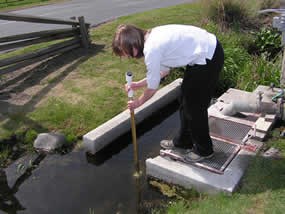
NPS People should get regular check-ups and so should parks. The “Vital Signs” program monitors the health of park ecosystems and landscapes, providing park staff with information they need to keep the parks healthy into the future.
Water is Life Though small in size, Whitman Mission National Historic Site is important to many plants and animals. Visitors sometimes see deer, mink, river otters, weasels, or even moose. Over 200 kinds of birds live in or pass through the park. Each species needs particular conditions to survive, but water is critical to all. Is it fit to drink (or live in)?
What “Bugs” Can Tell Us Many creatures live in the water. In addition to insects and insect larvae, one can find worms, snails, clams, and crustaceans. Collectively called “Macroinvertebrates”, these animals can tell park staff a lot about the health of the water. Streams will be sampled every three years. The presence of pollution sensitive species indicates that the water is healthy. Changes in the diversity of macroinvertebrates can indicate other changes in water quality. |
Last updated: March 1, 2015
